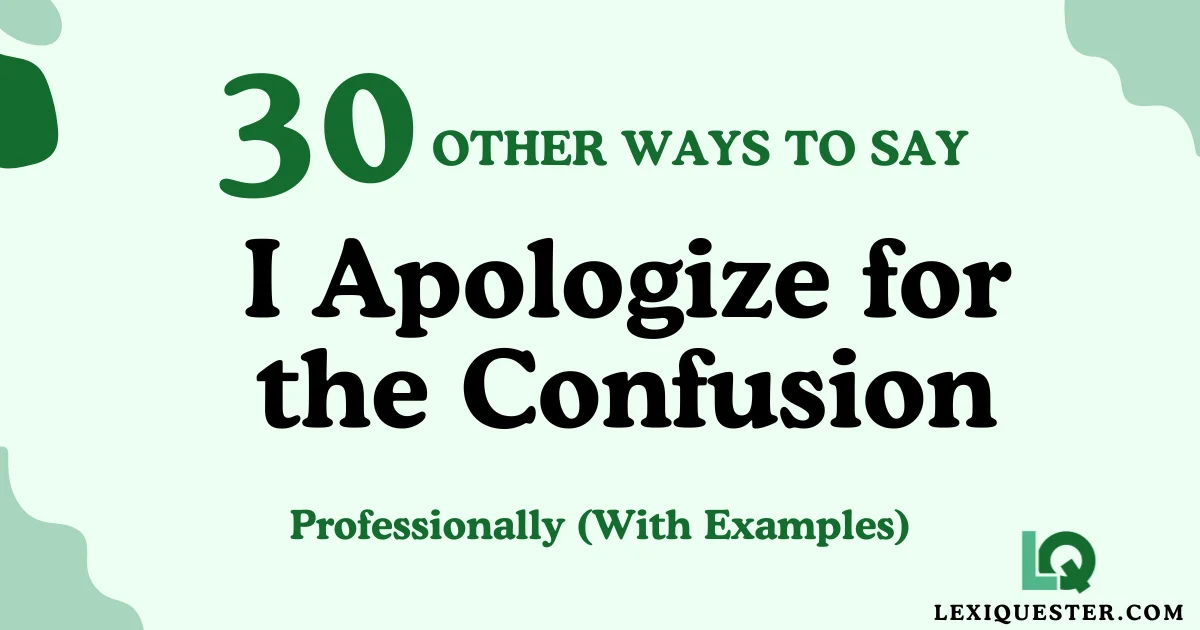Finding the right words when addressing misunderstandings or miscommunications can be challenging. “I apologize for the confusion” is a commonly used phrase, but there are many alternatives that can convey the same sentiment while sounding both empathetic and professional.
Whether you’re addressing a colleague, client, or team member, these alternative phrases help you express care and clarity in a way that resonates and strengthens your communication.
What Does “I Apologize for the Confusion” Mean?
“I apologize for the confusion” is an expression used to acknowledge a misunderstanding, mistake, or unclear communication that may have led to some level of frustration or inconvenience for the other party. It shows accountability, a willingness to correct the situation, and a commitment to clear communication moving forward.
When to Use “I Apologize for the Confusion”
This phrase is typically used when there’s a need to acknowledge that something may not have been clear or well-understood. It’s often used in professional settings when explaining errors in communication, directions, or instructions. It is an opportunity to take ownership and offer clarification or further assistance.
Is It Professional/Polite to Say “I Apologize for the Confusion”?
Yes, saying “I apologize for the confusion” is both polite and professional. It shows humility, emotional intelligence, and a proactive approach to resolving misunderstandings. It’s important to use such phrases thoughtfully, ensuring they align with the context and the tone of the situation.
I Apologize for the Confusion Alternatives:
- I’m Sorry for Any Misunderstanding
- Please Accept My Apologies for the Confusion
- I Regret Any Confusion Caused
- I Apologize for the Lack of Clarity
- I’m Sorry for Any Inconvenience
- My Apologies for the Miscommunication
- I Apologize for Any Confusion That May Have Arisen
- Please Forgive Me for Any Confusion
- I’m Sorry for the Lack of Explanation
- I Apologize for the Misunderstanding on My Part
- I Apologize for the Confusion I Caused
- I’m Sorry for Any Uncertainty Created
- I Apologize for Not Being Clear Enough
- I Am Sorry for Any Confusion That Has Occurred
- I Apologize for Any Confusion You May Have Encountered
- I’m Sorry for the Lack of Understanding
- I Apologize for Any Ambiguity
- I’m Sorry for the Confusion That Has Been Caused
- I Apologize for Any Misinterpretation
- I Regret Any Confusion or Discomfort
- I Apologize for the Uncertainty Created
- I’m Sorry for Any Confusion That May Have Occurred
- I Apologize for Any Inconsistencies in Communication
- Please Accept My Sincere Apologies for the Confusion
- I’m Sorry for Any Mixed Signals
- I Apologize for the Confusion in the Process
- I’m Sorry for the Ambiguity in My Message
- Please Allow Me to Clarify Any Confusion
- I Apologize for Any Confusion That May Have Resulted from My Actions
- I’m Sorry for Any Lack of Coordination
1. I’m Sorry for Any Misunderstanding
- Meaning: An apology acknowledging that something may not have been clear.
- Definition: This expression indicates that the speaker is aware of a possible miscommunication and expresses regret for any confusion caused.
- Example: “I’m sorry for any misunderstanding regarding the project timeline.”
- Tone: Empathetic, considerate.
2. Please Accept My Apologies for the Confusion
- Meaning: A more formal and polite way to apologize for causing confusion.
- Definition: A respectful acknowledgment that an error or misunderstanding has occurred, coupled with an apology.
- Example: “Please accept my apologies for the confusion surrounding the report format.”
- Tone: Formal, respectful.
3. I Regret Any Confusion Caused
- Meaning: Acknowledging that confusion has occurred, with an expression of regret.
- Definition: A thoughtful apology that shows responsibility for the misunderstanding and a desire to remedy the situation.
- Example: “I regret any confusion caused by the sudden change in the schedule.”
- Tone: Sincere, regretful.
4. I Apologize for the Lack of Clarity
- Meaning: Apologizing for not being clear enough in communication.
- Definition: This apology takes responsibility for a lack of clear communication and offers a chance to clarify.
- Example: “I apologize for the lack of clarity in the instructions I provided.”
- Tone: Professional, responsible.
5. I’m Sorry for Any Inconvenience
- Meaning: A general apology for causing inconvenience, often used when confusion results in delays.
- Definition: This phrase shows an understanding that the confusion may have caused unnecessary disruption or inconvenience.
- Example: “I’m sorry for any inconvenience caused by the delay in responding to your query.”
- Tone: Empathetic, considerate.
6. My Apologies for the Miscommunication
- Meaning: Acknowledging a breakdown in communication that led to confusion.
- Definition: A clear admission that a miscommunication occurred, with a polite apology for any inconvenience.
- Example: “My apologies for the miscommunication regarding the meeting location.”
- Tone: Apologetic, respectful.
7. I Apologize for Any Confusion That May Have Arisen
- Meaning: A slightly more formal way to acknowledge confusion and offer an apology.
- Definition: This phrase expresses a recognition that confusion might have occurred without assuming fault but still offering an apology.
- Example: “I apologize for any confusion that may have arisen from my email.”
- Tone: Formal, professional.
8. Please Forgive Me for Any Confusion
- Meaning: A request for forgiveness after causing confusion.
- Definition: A sincere apology that requests understanding and forgiveness for any unclear communication.
- Example: “Please forgive me for any confusion about the meeting agenda.”
- Tone: Apologetic, humble.
9. I’m Sorry for the Lack of Explanation
- Meaning: Acknowledging that an insufficient explanation may have caused confusion.
- Definition: This apology is used when the speaker realizes they did not provide enough detail to prevent confusion.
- Example: “I’m sorry for the lack of explanation in my earlier message.”
- Tone: Honest, regretful.
10. I Apologize for the Misunderstanding on My Part
- Meaning: Taking full responsibility for the misunderstanding.
- Definition: A self-reflective apology that acknowledges personal responsibility in causing confusion.
- Example: “I apologize for the misunderstanding on my part regarding the project requirements.”
- Tone: Humble, responsible.
11. I Apologize for the Confusion I Caused
- Meaning: A straightforward admission of responsibility for the confusion.
- Definition: This apology directly takes accountability for the confusion that has occurred.
- Example: “I apologize for the confusion I caused regarding the changes to the schedule.”
- Tone: Direct, responsible.
12. I’m Sorry for Any Uncertainty Created
- Meaning: Apologizing for creating an unclear or uncertain situation.
- Definition: A phrase that acknowledges the role the speaker may have played in causing confusion and offers a polite apology.
- Example: “I’m sorry for any uncertainty created by the recent changes.”
- Tone: Considerate, understanding.
13. I Apologize for Not Being Clear Enough
- Meaning: Admitting that the communication was not as clear as it should have been.
- Definition: A humble apology recognizing the lack of clarity in communication.
- Example: “I apologize for not being clear enough in my previous email.”
- Tone: Self-aware, polite.
14. I Am Sorry for Any Confusion That Has Occurred
- Meaning: A general apology acknowledging that confusion has taken place.
- Definition: A phrase that simply acknowledges confusion without assuming fault but expressing regret.
- Example: “I am sorry for any confusion that has occurred regarding the document submission.”
- Tone: Empathetic, professional.
15. I Apologize for Any Confusion You May Have Encountered
- Meaning: Recognizing that confusion has affected the other party.
- Definition: A considerate apology acknowledging the other person’s experience of confusion.
- Example: “I apologize for any confusion you may have encountered with the instructions.”
- Tone: Considerate, empathetic.
16. I’m Sorry for the Lack of Understanding
- Meaning: Apologizing for causing a situation where understanding was not achieved.
- Definition: This phrase admits that something in communication led to confusion or a lack of clarity.
- Example: “I’m sorry for the lack of understanding regarding the team’s responsibilities.”
- Tone: Professional, regretful.
17. I Apologize for Any Ambiguity
- Meaning: Acknowledging that something may have been unclear or vague.
- Definition: A formal apology for causing uncertainty or ambiguity in communication.
- Example: “I apologize for any ambiguity in my earlier message regarding the project scope.”
- Tone: Formal, respectful.
18. I’m Sorry for the Confusion That Has Been Caused
- Meaning: A direct apology acknowledging the confusion caused.
- Definition: A clear and unambiguous expression of regret for the confusion.
- Example: “I’m sorry for the confusion that has been caused by the new procedure.”
- Tone: Professional, direct.
19. I Apologize for Any Misinterpretation
- Meaning: Acknowledging that information may have been misunderstood.
- Definition: This phrase apologizes for the possibility that the information was not interpreted as intended.
- Example: “I apologize for any misinterpretation of the email I sent earlier.”
- Tone: Apologetic, professional.
20. I Regret Any Confusion or Discomfort
- Meaning: Apologizing not only for the confusion but also for any discomfort it may have caused.
- Definition: A compassionate apology recognizing both the confusion and any emotional impact it may have had.
- Example: “I regret any confusion or discomfort caused by the last-minute changes.”
- Tone: Compassionate, empathetic.
21. I Apologize for the Uncertainty Created
- Meaning: Acknowledging that confusion or ambiguity has caused uncertainty.
- Definition: This apology expresses regret for creating an unclear or uncertain situation that affected others.
- Example: “I apologize for the uncertainty created by the lack of details in the initial proposal.”
- Tone: Polite, considerate.
22. I’m Sorry for Any Confusion That May Have Occurred
- Meaning: A general apology that recognizes the possibility of confusion.
- Definition: A flexible and thoughtful way to acknowledge that confusion might have occurred without assuming full responsibility.
- Example: “I’m sorry for any confusion that may have occurred during our discussion yesterday.”
- Tone: Considerate, careful.
23. I Apologize for Any Inconsistencies in Communication
- Meaning: Acknowledging that the communication may not have been consistent.
- Definition: This phrase takes responsibility for any inconsistencies in the message that could have caused confusion.
- Example: “I apologize for any inconsistencies in communication related to the project timelines.”
- Tone: Honest, responsible.
24. Please Accept My Sincere Apologies for the Confusion
- Meaning: Offering a heartfelt and sincere apology for the confusion.
- Definition: A formal and respectful apology that conveys sincerity and earnestness.
- Example: “Please accept my sincere apologies for the confusion caused by the mix-up with the report.”
- Tone: Formal, sincere.
25. I’m Sorry for Any Mixed Signals
- Meaning: Apologizing for sending unclear or conflicting messages.
- Definition: This expression recognizes that conflicting messages may have led to confusion.
- Example: “I’m sorry for any mixed signals in the communication about the deadline.”
- Tone: Casual, understanding.
26. I Apologize for the Confusion in the Process
- Meaning: Apologizing for a lack of clarity in a process that caused confusion.
- Definition: This phrase indicates that confusion arose due to unclear steps or procedures, and the speaker takes responsibility.
- Example: “I apologize for the confusion in the process of submitting the reports.”
- Tone: Professional, accountable.
27. I’m Sorry for the Ambiguity in My Message
- Meaning: Admitting that the message was unclear or vague.
- Definition: Acknowledging that the communication lacked clarity, leading to ambiguity and confusion.
- Example: “I’m sorry for the ambiguity in my message; let me clarify the details for you.”
- Tone: Apologetic, helpful.
28. Please Allow Me to Clarify Any Confusion
- Meaning: Offering to explain and clear up any confusion.
- Definition: This phrase is used to take responsibility for the confusion and offer further clarification.
- Example: “Please allow me to clarify any confusion about the meeting agenda.”
- Tone: Helpful, polite.
29. I Apologize for Any Confusion That May Have Resulted from My Actions
- Meaning: Acknowledging that actions taken may have led to confusion.
- Definition: This expression admits that the speaker’s actions, rather than words, could have caused confusion.
- Example: “I apologize for any confusion that may have resulted from my actions regarding the delivery schedule.”
- Tone: Responsible, reflective.
30. I’m Sorry for Any Lack of Coordination
- Meaning: Apologizing for not being coordinated in actions or communication, which led to confusion.
- Definition: This phrase conveys regret for not ensuring smooth communication or collaboration, leading to misunderstanding.
- Example: “I’m sorry for any lack of coordination on the team’s part in organizing the event.”
- Tone: Apologetic, professional.
Conclusion
In any professional setting, clear communication is key to ensuring smooth and effective interactions. Whether you’re communicating with colleagues, clients, or partners, taking the time to apologize for confusion in a thoughtful and professional manner not only resolves the issue but also strengthens relationships.
The alternatives presented here provide a variety of ways to acknowledge misunderstandings while maintaining a respectful and empathetic tone.
Recent Posts
30 Other Ways to Say “I Was Wondering” Professionally (With Examples)
30 Other Ways to Say “Token of Appreciation” Professionally (With Examples)
30 Other Ways to Say “I Called You, But You Didn’t Answer” Professionally (With Examples)
30 Other Ways to Say “Food Will Be Served on an Invitation” Professionally (With Examples)
30 Other Ways to Say “Thank You for Your Interest” Professionally (With Examples)














